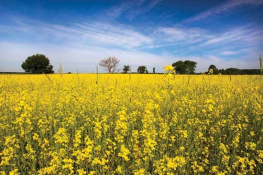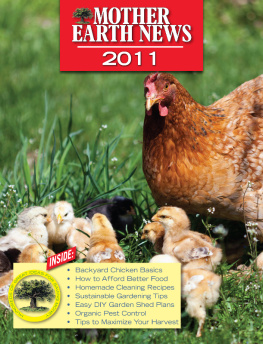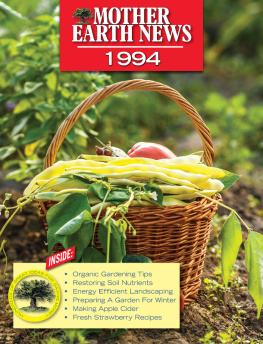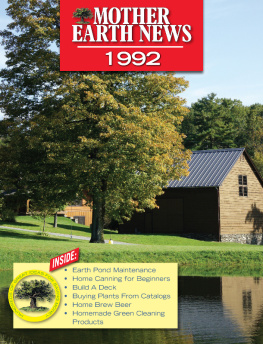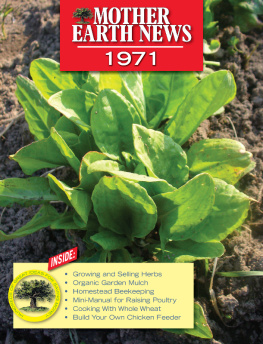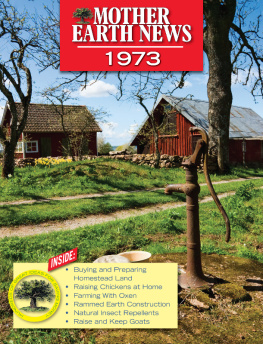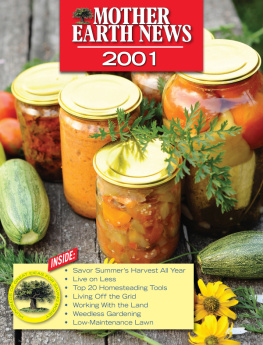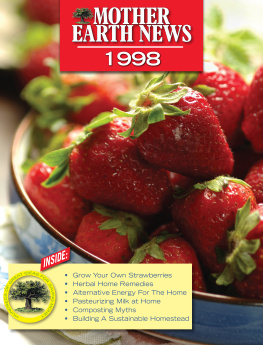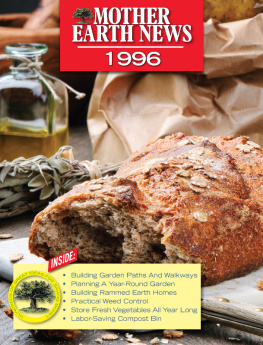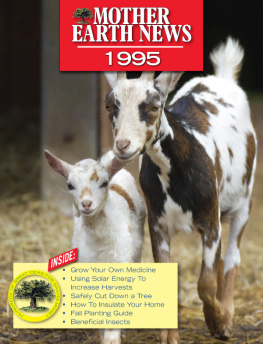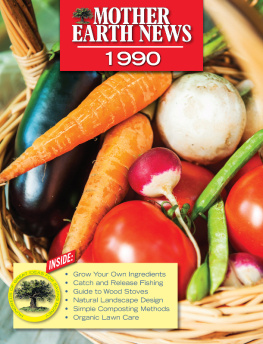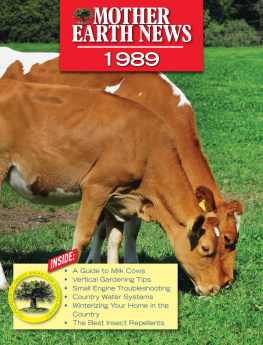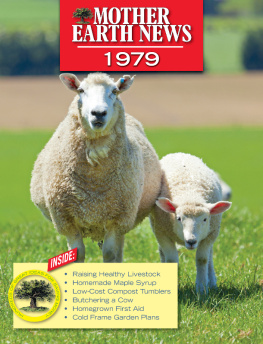Mother Earth News - Mother Earth News 2018
Here you can read online Mother Earth News - Mother Earth News 2018 full text of the book (entire story) in english for free. Download pdf and epub, get meaning, cover and reviews about this ebook. year: 2018, publisher: Mother Earth News, genre: Science / Home and family. Description of the work, (preface) as well as reviews are available. Best literature library LitArk.com created for fans of good reading and offers a wide selection of genres:
Romance novel
Science fiction
Adventure
Detective
Science
History
Home and family
Prose
Art
Politics
Computer
Non-fiction
Religion
Business
Children
Humor
Choose a favorite category and find really read worthwhile books. Enjoy immersion in the world of imagination, feel the emotions of the characters or learn something new for yourself, make an fascinating discovery.
- Book:Mother Earth News 2018
- Author:
- Publisher:Mother Earth News
- Genre:
- Year:2018
- Rating:3 / 5
- Favourites:Add to favourites
- Your mark:
- 60
- 1
- 2
- 3
- 4
- 5
Mother Earth News 2018: summary, description and annotation
We offer to read an annotation, description, summary or preface (depends on what the author of the book "Mother Earth News 2018" wrote himself). If you haven't found the necessary information about the book — write in the comments, we will try to find it.
Mother Earth News 2018 — read online for free the complete book (whole text) full work
Below is the text of the book, divided by pages. System saving the place of the last page read, allows you to conveniently read the book "Mother Earth News 2018" online for free, without having to search again every time where you left off. Put a bookmark, and you can go to the page where you finished reading at any time.
Font size:
Interval:
Bookmark:

In some parts of the country, the tide is turning against toxic pesticides. The herbicide Dicamba has been temporarily banned in Missouri and Arkansas after hundreds of farmers filed complaints that it was harming their crops. Though the product has been used agriculturally for decades, Dicamba hasnt technically been approved by the U.S. Environmental Protection Agency and isnt legal in every state.
No single chemical company owns the rights to Dicamba, but Monsanto is a major distributor. To promote its use, the company recently began selling Dicamba-resistant cotton and soybean seeds. This allows farmers to spray the herbicide more frequently without putting their crops at risk. But Dicamba will still damage other plants, meaning neighboring farms may lose their harvests unless they also buy resistant seeds. While pesticide drift is a common agricultural problem that usually affects a handful of fields at a time, estimates show that Dicamba alone could affect 2 million acres of cropland every year.
For now, farmer complaints have led to the ban of all Dicamba-based products in Missouri and Arkansas. In these states, farmers who sell or use these products may incur civil penalties. Though legislatures insist the ban is a temporary measure, most agree that its unfair for farmers to lose their crops because of the actions of their neighbors.
Proprietary seeds and chemical pesticides go hand in hand.
Photo by Getty Images/fotokostic
All greenhouses use the sun for heat during the day. At night, most greenhouses quickly lose that heat because of the poor insulating quality of their materials. The reason for this inefficiency has to do with some basic principles of traditional greenhouse design that focus on maximizing light. Glazing materials, such as glass or clear plastic, are good at letting in light, but theyre terrible at retaining heat.
Solar greenhouse design takes a different approach, finding a balance between glazing and insulation to create a structure that naturally resists overheating and overcooling without reliance on fossil fuels. Instead, the sun provides the energy, and the greenhouse collects and stores that energy to provide its own heating when required. The use of thermal mass materials is the oldest and simplest strategy for storing heat and naturally mitigating temperature swings.
When light hits a material, some of it is absorbed and converted to heat. Thermal mass materials absorb this heat via conduction. Heat slowly conducts from the surface to the center of the mass, allowing the entire volume to heat up by a few degrees in a day. When the air temperature in the greenhouse drops at night, the mass slowly starts radiating this heat through conduction and by releasing short-wave infrared radiation. In this way, thermal mass regulates the temperature of the greenhouse. It absorbs energy from the sun during the day and slowly re-radiates it as heat at night (or whenever the air temperature drops below the temperature of the mass), which evens out daily temperature swings.
Because mass materials store heat, theyre often referred to as heat sinks, thermal banks, or thermal batteries. The idea is the same: to store as much heat as possible when its oversupplied, and slowly distribute it when its in demand. To make this possible, you must maximize the materials exposure to light in winter (or whenever greenhouse heating is needed). This will allow the sinks to charge as much as possible during the day so they can radiate heat later. Even if the materials arent directly illuminated, theyll still absorb some heat from the surrounding air. This means they can have some effect on overcast days; however, the predominant driver of a sinks ability to store heat is direct light absorption.
During summer, the goal of thermal mass is to help keep a greenhouse cool. To that end, the mass should be shaded during summer months. On summer days, it will still absorb some heat from the greenhouse as hot air moves across it. It will then radiate this heat at night, given a sufficient drop in temperature, and resume cooling the next day.
All materials absorb and store heat to some extent, but some are much more effective than others. The amount of heat a material can store is called its heat capacity and is determined by two factors. First, the materials specific heat is a property of the material, defined as how much energy is required to raise its temperature 1 degree Fahrenheit.
Density is the second factor that affects a materials heat capacity. The more mass in a given volume, the more energy it can store. Most mass materials, such as stone and concrete, are effective because theyre dense.
When you multiply these two characteristics specific heat and density the result is a materials volumetric heat capacity (check out the chart below for the volumetric heat capacities of common building materials). This is the most useful unit of measurement because it indicates the total heat stored in a given volume of the material. In a greenhouse setting, volume is an extremely important factor because mass materials can take up considerable space that could be otherwise used for growing.
| |
Material | Heat Capacity per Volume (Btu/ft3/F) |
Water* | |
Steel | |
Rock or stone (30 percent air gaps) | |
Soil (damp, light soil) | |
Concrete | 25 to 32 |
Brick | 23 to 35 |
Adobe | |
Wood (pine or fir) | |
Sand | |
Air | 0.018 |
*Helpful conversion: 1 gallon of water has a volumetric heat capacity of 8.34 Btu. |
Note that heat capacity is a different property than conductivity, the rate at which a material conducts or transfers heat. Thermal mass materials arent good insulators, generally speaking. They can store a lot of heat, but they easily conduct heat with their surroundings. This means they should be insulated from the exterior and shouldnt be substituted for insulation.
Every greenhouse inherently contains some thermal mass in its structure, soil, water, and plants. While not insignificant, these sources of mass are usually not enough to provide year-round climate control. Thus, thermal mass materials are integrated in larger quantities, usually via water or masonry.
Water is far and away the most commonly used thermal mass in greenhouses. It has the highest heat capacity per volume of any readily available material, and its cheap. Stacking several large drums of water on the north wall of a greenhouse will create a water wall, a large, low-cost thermal battery.
Water walls should be exposed to light in winter and shaded in summer. A partially insulated roof can easily accomplish this if the water barrels are on the north wall of the greenhouse. The length of the insulation will determine when the water wall is exposed to light or shaded, based on the solar angles at your location (the University of Oregon offers a software tool to create sun path diagrams). To find the right length of insulation, sketch the greenhouse profile, the dimensions of the water barrels, and the solar altitude angles during the solstices (or equinoxes). By using a protractor or a program such as SketchUp, you can estimate the length of roof insulation that will allow the mass to be shaded in summer and fully illuminated in winter. (See illustration in slideshow).
Font size:
Interval:
Bookmark:
Similar books «Mother Earth News 2018»
Look at similar books to Mother Earth News 2018. We have selected literature similar in name and meaning in the hope of providing readers with more options to find new, interesting, not yet read works.
Discussion, reviews of the book Mother Earth News 2018 and just readers' own opinions. Leave your comments, write what you think about the work, its meaning or the main characters. Specify what exactly you liked and what you didn't like, and why you think so.

